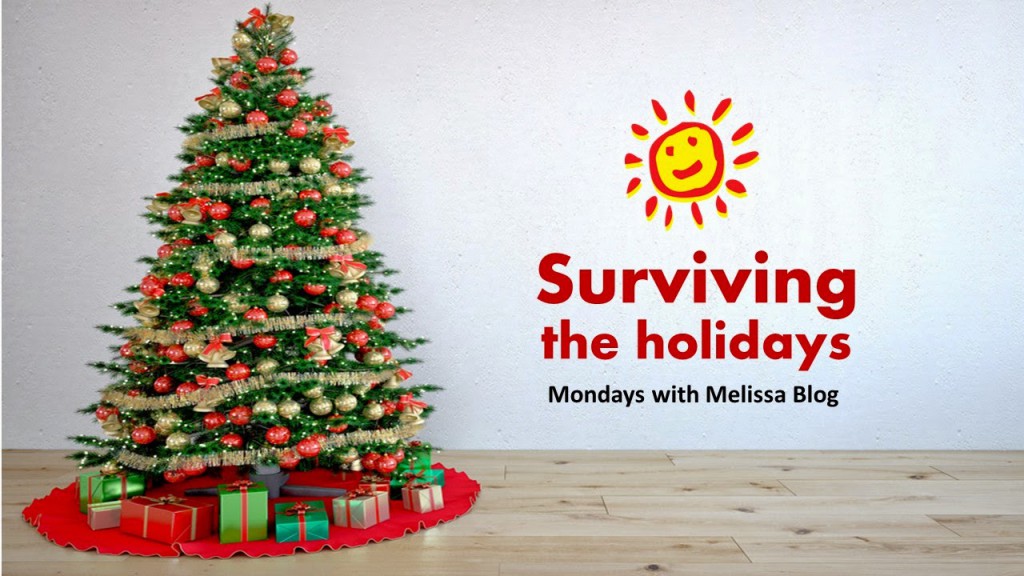Dear Melissa,
Any ideas to help make the holidays run smoothly for my son with Sensory Processing Disorder?
Thanksgiving, Hanukkah, Christmas, Kwanzaa, New Year’s…the holiday season is upon us! The holidays are a time of big changes in routine for most families. These changes can be particularly difficult for children with Sensory Processing Disorder. With new foods, new clothes, new smells, new people, new routine…it can be the perfect recipe for a meltdown! Here are a few ideas to help set realistic goals & expectations for this holiday season.
- Keep to your standard routine as much as possible.
Great fluctuations in sleeping habits and meal times can create hungry, cranky, tired children (and adults!). The more you can stay with your typical nap, bedtime, and mealtime routine, the better. If your child tends to sleep well in the car, it may be helpful to plan car trips during nap time or to pack PJs and toothbrush so that your child can complete the bedtime routine at Grandma’s house BEFORE you take the long trip home. It may also be helpful to keep healthy snacks handy if mealtimes get delayed.
- Consider clothing requirements with holiday outfits.
Many children who have tactile defensiveness are defensive toward various textures/styles of clothing. A child who only wears sweatpants and t-shirts is not suddenly going to be happy wearing a button up shirt tucked in with a belt, just because it is Christmas Eve! Consider choosing holiday outfits with softer fabrics…as close as possible to the style that the child prefers. A happy child in soft khaki pants and a polo-style shirt looks much more appropriate than a child throwing a tantrum in a suit. For girls, consider soft cotton dresses and avoid excess lace, taffeta, tulle, tights, and other scratchy fabrics. If you have a special outfit in mind that you think may be troublesome, try having the child wear the special outfit around the house on a calm afternoon so they can get begin to get used to it in a less stressful environment. Another good idea is to purchase 2-3 appropriate outfits (keeping receipts and tags) and let your son choose his favorite. Again, it is amazing how a bit of control can greatly improve a child’s compliance!
- Remember special diets and food allergies.
Make sure you inform all people preparing food of these restrictions so that you can learn ahead of time what your child can/can’t eat, and you can bring additional dishes if needed. No one wants to end up in the ER during the holidays because of a food reaction!
- Remember your picky eater’s preferences.
In general, it is good to encourage trying new foods. However, this is NOT the time. Simply dealing with the change in routine of the holidays is enough. Make sure that there is something on the menu that your child will eat, or just bring a lunchbox!
- Consider alternate traditions surrounding presents.
Many children with sensory processing disorder love routines and hate surprises. This often makes the idea of opening presents very stressful. Some of these children prefer for presents to not be wrapped. Other children prefer to unwrap presents at a time other than in the middle of the chaos of the holidays.
- Set realistic expectations for social interaction with extended family.
A child who has social anxiety won’t suddenly warm up to Aunt Susan who the child hasn’t seen in 6 months. This can be a source of hurt feelings for both the parent and the extended family member. If you think this may be a problem, it is important to let Aunt Susan know that her nephew has difficulties with social skills, and this is an area that you all are presently working on. But then actually work on it! Consider having your child practice an appropriate greeting (such as a “high five”) prior to family arriving and role play how he should interact with various family members.
- Set realistic expectations surrounding holiday ceremonies.
Consider how long your child can reasonably sit in one location, the level of noise involved, how crowded the situation will be, what will be your escape strategy, etc. A little planning can help set your child up for success.
- Designate a quiet “safe zone.”
This can be a quiet closet, inside tent, or bedroom away from all of the hustle and bustle of the holiday. Line the space with blankets, pillows, and stuffed animals and allow for quiet music and soft lights. Ideally, this is NOT a space for electronics, as they can be too stimulating. More appropriate activities for this space include books, fidget toys, or coloring. Your child should be allowed to go to this space anytime they feel overwhelmed by the chaos of the holidays. (Don’t we all wish we had a space like this!)
- Create a social story.
Your speech therapist or occupational therapist can help with this. A social story is simply a story that you create with your child to describe a setting and/or task of particular difficulty. This story book depicts a situation with your child as the main character and then describes the proper way to act. These stories work because they help inform the child concerning expectations and proper responses to the situation. The story is stronger if it contains pictures of the child being successful in these situations.
With a little planning and preparation, the holidays
CAN be an enjoyable time for everyone!
What holiday survival tips have worked for your family?
I would love to hear your tips/ideas!
You can send questions to share@ChildrensTherapyTEAM.com
Resources:
4 Tips for Preparing your Child with Autism for Holiday Celebrations, Huffington Post
Holiday tips for Children with Autism,Siblings, Psychology Today
Holiday Survival Tips for Families of Children with Special Needs, Mama OT

